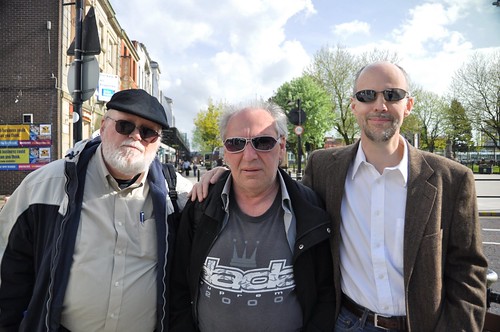Langpo, vidpo, vispo: RS, Tom Konyves, Geof Huth
(Photo by Nancy F. Huth)
Tom Konyves has a mission. The poet, a longtime veteran of the Montreal &
Imagine, if you will, the early days of visual poetry, back when it was still called concrete poetry, if you suddenly had a flood of thousands of participants. Far from ensuring the ongoing evolution of vispo, that kind of early inundation might well have kept it from developing a vocabulary all its own, made it impossible to actually see what the terms and implications might be in developing an art that was, at once, both linguistic & graphic, reduced it to a fad.
Videopoetry, one word or two, has added complications to deal with. First of all, one can begin with almost any definition of the poem, from the most graphic to almost pure sound poetry to the most traditional verse form conceivable. Second: what one adds, when one adds video, can itself differ dramatically from case to case. At one extreme, one might have what is simply a graphic text that employs movement (with or without color). At the other, one might have an elaborate staging of a text, involving actors, special effects, a score. Because video derives historically from film, it brings with it a culture of collaboration that is quite apart from what goes on in most poetry.
Even if you subtract from this category all the videos that are simply documentation of readings – by far the most numerous – the range of what might be done is simply staggering. And the temptation to simply import what has been done elsewhere, in other film contexts, can be overwhelming. Thus Billy Collins’ The Dead is animated by Juan Delcan, neither poem nor cartoon threatening to break any new ground whatsoever. At least the visual is in the same spirit as the text itself. At the other end of the spectrum, many of the videos of Nico Vassilakis attempt to tackle the potential in this new form head on. The role of text, sound, movement and color may all be in play, but Vassilakis approaches them closer to the way Cecil Taylor approaches the piano – as something to be explored, as such. A work like Konyves’ own Sign Language (1985) stakes out a middle ground, using found language principally in signage & graffiti to articulate a vision of life lived on the economic edge. A jazz score underscores the point-of-view as clearly as does the documentary mode employed.
Konyves tells me that he sees this landscape dividing into five major tendencies, although I don’t yet know what those are. He dates his own usage of the term videopoem to 1978, tho notes that Richard Kostelanetz may have been using it as early as 1973. 1973 just also happened to be the year that Frank & Caroline Mouris’ Frank Film won the Oscar for best short subject. If Frank Film isn’t a videopoem, it may only be because the category was still embryonic when it was filmed. It is interesting to think that the ingredients were all there 30-plus years ago & yet videopoetry is still very much in its infancy. But as I noted to Tom, if you trace the history of the prose poem back to Aloysius Bertrand’s Gaspard de la nuit, the videopoem isn’t really so far behind schedule. What it mostly lacks, so far as I can tell, is its Baudelaire – the one individual whose work will force everyone to sit up and take notice.
One reason for this lack might well be an issue that all of these poets – from Collins to Vassilakis – are forced to confront. For videopoetry to exist, the form has to be able to distinguish itself from the gumbo that is intermedia. Or perhaps polymedia would be a more accurate term. Collins’ piece is nothing more than a reading of the piece over which a cartoon has been superimposed. The use of language is more interesting in the pieces by Konyves & Vassilakis, but each imports elements from other media, other worlds. Vassilakis treats his sound track more as a score, and more than a few of his visuals harken back to the heyday of lightshows that accompanied the rock bands of the late ‘60s and early ‘70s. One could argue further that his conception of the poem here likewise depends heavily on vispo at least as a starting place. In that regards, Konyves’ use of appropriation & quotation has much in common with some aspects of langpo, some of the
There is of course nothing wrong with inter- or polymedia – but the dynamics of everything in the pot, so to speak, comes at a steep price if what you’re after is the evolution of a particular medium. I’m tempted to return to Baudelaire’s famous letter to Arsene Houssaye which serves as preface to Paris Spleen, written 33 years after Gaspard, and which Baudelaire characterizes as having
neither head nor tail, since, on the contrary, everything in it is both head and tail, alternately and reciprocally.
Thirty-six years after the Mourises’ Frank Film, I have yet to see a work that more completely fit my own sense of what a videopoem might be, tho both Konyves & Vassilakis seem to me to be in the ballpark. In each we can glimpse some aspect of what the medium holds. It will be interesting to see how it unfolds going forward, particularly when the technology takes us away from video as we now know it (e.g. flash poetry), which is as predictable as overcast skies in the North of England.






